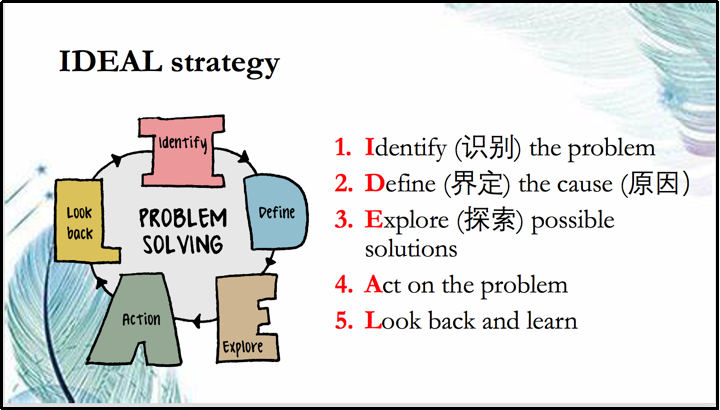绝了!上海世外教师告诉你,新课标下的阅读教案怎么写!
Chapter 12 Contrast: Simple Present and Present Continuous Tenses; Adjectives
Feelingsand Emotions; Describing Usual and Unusual Activities
Reading: A Bad Day at the Office
【设计思路】
1.素材分析
1)What?
A Bad Day at the Office是SBS第12章节的一篇阅读材料。本章节的话题围绕着一些常见和不常见的活动展开,通过提供一个个真实、有趣的生活情景,帮助学生区分一般现在时和现在进行时。本课文围绕一位Acme互联网公司的总裁Blaine先生糟糕的一天展开,由于他的所有员工今天都不在公司,他不得已要“身兼多职”,完成一项项琐碎的办公室任务。
2)How?
本文是一篇结构工整的记叙文,标题简单扼要地概述了故事的主要内容和场景,插图生动有趣地展现出故事主人公Blaine先生在办公室忙碌工作、焦头烂额的画面,能帮助学生更好地预测故事内容、理解文本中的词汇,如sort the mail, custodian, on strike等。
全文共分三段,结构清晰,首段简要介绍了故事发生的时间、地点、人物,及主要事件,第二段具体描述了主人公正在做的每一项工作,及每个员工缺席的原因;尾段总结全文,概述Blaine先生在办公室里忙碌的状态,并进一步点题。
本文第二段运用了由who引导的定语从句,依次介绍与办公室有关的职位和其相应的职责。与此同时,运用现在进行时描述主人公的动作,运用一般现在时描述职员日常的职责。
3)Why?
学生通过阅读本文可以体会到当偶发事件发生时,主人公的手忙脚乱和焦急无助。同时,学生可以站在主人公的角度,分析这一起偶然事件发生的原因、提出解决问题的方法、并进一步思考如何避免同样问题的再次出现。由此,学生可以联系自身情况,思考自己在日常生活中碰到各类问题时,如何运用逻辑思维能力,分析原因、解决问题并从中积累经验。
由于新冠疫情的爆发,授课期间学生不得不在家上网课。面对这一个新的全球性“问题”,作为一个普通的学生又该如何应对?通过联系实际生活,可以帮助学生更好地感悟面对问题,沉着应对、分析思考、并从中反思学习的重要性。
2.学情分析
本课以录课形式,借助网络对全体世外六年级学生授课。通过六年级上半学期的反复操练,本年级大部分学生已掌握了现在进行时和一般现在时的用法,并善于发挥想象力,对图片、文本内容进行发散性思考,用英语表达自己的观点。但是多数同学对于who引导的定语从句的用法并不了解;此外,在整合信息、逻辑推理和分析的能力方面还有所欠缺。大多数同学能独立解决问题,但是对于解决问题的策略并没有系统的思考和认识。
3.教学策略
为了培养学生形成理性思考、分析解决问题的意识,笔者运用课文材料作为案例,一步步指导学生如何使用“IDEAL策略”,即Identifythe problem(识别问题)、Define the cause(界定原因)、Explore the solutions(探索解决方法)、Act on the problem(采取行动)、Look back and learn(反思并学习)五个步骤,来解决日常生活中的实际问题。
在教授“IDEAL策略“的过程中,本课还融入了阅读策略的教授,例如通过解读文本特征(图片、标题)进行预测和略读、运用线索词(context clues),定位文本中的关键信息;通过上下文逻辑关系和看插图,猜测词义等;通过与文本建立联系(making connections),学习如何对文本信息进行评价。
4.学习目标
通过本课的学习,希望学生能够在如下方面得到提升:
(1)通过略读、细读、预测等阅读策略,梳理与故事相关的事实性信息,提升对语篇的理解和运用。
(2)通过结合文本和生活经验,概括分析导致问题的原因、可能的解决方法和对未来的启迪。
(3)通过运用IDEAL问题解决策略,提高分析、解决、反思问题的能力。
5.学习难点
(1)理解IDEAL策略中每个字母所对应的问题解决步骤的内涵。
(2)运用IDEAL策略,推理分析导致问题的根本原因;探索解决办法并从中习得经验。
【学习目标】
At the end of the lesson, students are expected to:
1.understand Mr. Blaine’s story by using the reading strategies such as skimming, scanning and predicting;
2.analyze the cause of Mr. Blaine’s problem, explore the solutions to his problem and learn from his problem by making connections between Mr. Blaine’s story and their personal experience;
3.improve the problem-solving skills by using the IDEAL strategy in daily life.
【学习重难点】
1.Understanding the concept of the IDEAL strategy.
2.Applying the IDEAL strategy to analyze the rootcause of the problem, explore the possible solutions and learn from the problem.
【活动设计】
Warm-up
活动 Thinkabout a problem and try to find out the solution. Watch a video clip and find out how a chimpanzee solved the problem. Summarize the steps of the problem-solving process.
Question 1:What will you do to get the peanuts at the bottom of the tube?
Question 2: In the video clip, what did the chimpanzee do to get the peanuts? What steps did she take?

通过思考一个日常生活中问题的解决办法,激发学生的学习兴趣。

通过观察科学实验,引导学生思考解决问题的基本步骤,初步理解IDEAL策略,对identify,define和explore几个抽象词汇的概念形成具象的理解。

通过生动的流程图和中文释义,了解本课的阿重点,即IDEAL问题解决策略的五个步骤,记录笔记。

通过联系“侦探破案”的过程阅读教案怎么写,理解解决问题的第一步是识别问题,而识别问题的主要方法是通过观察和提问来收集事实信息。
活动Lookat the title and the illustration. Make predictions about the story.
Question: Lookat the title and the picture. What information can you get from these text features?
通过略读和预测,大致了解文章的主旨、主人公所处的环境、心情和忙碌的工作状态,激发进一步阅读的兴趣。
While-reading Stage
活动1Read the first and the last paragraph. Circle who the man is and what he does. Underline his problem with a black pen and the cause of the problem with a red pen.
Question1:Who is the man? What position does he take?
Question 2: What’s his problem? What are the signal words?
Question 3: What’s the cause of his problem? What are the signal words?
通过细读,用不同颜色、方式圈划关键词、句,理清文本内容和结构。通过寻找信号词,进一步梳理故事的因果逻辑关系,理解as a result的释义和作用。
活动2 Read the secondparagraph.
Step 1: Circle who the employees are and introduce their responsibilities with the given sentence pattern: __(Position)__ is the one who usually ___(responsibility)__.
Question: Who are the employees? What do they usually do?

通过圈划,找到办公室不同职位的表达方式和相应的职责。通过看图并造句,理解每个职位和职责的含义。同时,学习如何使用who引导的定语从句介绍一个人的职责。
Step 2: Underline why the employees are out today.
Question1: Why are the employees absent? What are the signal words that show you the causes of the problem?
Question2: What are the custodians doing when they are on strike?

通过圈划,理清文本并列结构的内在因果逻辑。
通过插图和联系上下文,推断出on strike的含义,为之后探索问题的解决办法做铺垫。
活动3Analyze what isknown from the text and what remains unknown to the readers about Mr. Blaine’s problem.
Step 1: Raise further questions about the cause of Mr. Blaine’s problem.

运用流程图理清问题和导致问题的原因,并进一步分析在这一些表层原因背后的深层原因。通过不断地追问质疑,加深对文本内容的理解,提升对问题深度思考分析的能力。
Step 2: Give possible answers to the further questions.

通过结合生活经验,尝试回答自己提出的问题,分析不同的可能性,寻找导致问题的根本原因,更深入地理解IDEAL策略的第二步“界定原因”的含义。
Post-reading Stage
活动1:Describe Mr. Blaine’s possible feeling during the day. Brainstorm some suggestions for him to solve the problem.
Question 1: How does Mr. Blaine possibly feel today?
Question 2: What can he do next to solve the problem?

基于对文本的理解,与故事的主人公产生共情,进而为Blaine先生出谋划策,探索解决人员短缺问题的办法,提高发散性思维能力。
由此,进一步理解IDEAL策略的第三步“探索解决办法“的含义。
活动2:Listento four solutions offered by the schoolmates and take notes.
我也在不断的去追求